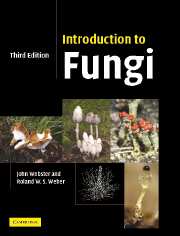Book contents
- Frontmatter
- Contents
- Preface to the first edition
- Preface to the second edition
- Preface to the third edition
- Acknowledgements
- 1 Introduction
- 2 Protozoa: Myxomycota (slime moulds)
- 3 Protozoa: Plasmodiophoromycota
- 4 Straminipila: minor fungal phyla
- 5 Straminipila: Oomycota
- 6 Chytridiomycota
- 7 Zygomycota
- 8 Ascomycota (ascomycetes)
- 9 Archiascomycetes
- 10 Hemiascomycetes
- 11 Plectomycetes
- 12 Hymenoascomycetes: Pyrenomycetes
- 13 Hymenoascomycetes: Erysiphales
- 14 Hymenoascomycetes: Pezizales (operculate discomycetes)
- 15 Hymenoascomycetes: Helotiales (inoperculate discomycetes)
- 16 Lichenized fungi (chiefly Hymenoascomycetes: Lecanorales)
- 17 Loculoascomycetes
- 18 Basidiomycota
- 19 Homobasidiomycetes
- 20 Homobasidiomycetes: gasteromycetes
- 21 Heterobasidiomycetes
- 22 Urediniomycetes: Uredinales (rust fungi)
- 23 Ustilaginomycetes: smut fungi and their allies
- 24 Basidiomycete yeasts
- 25 Anamorphic fungi (nematophagous and aquatic forms)
- References
- Index
- Plate section
18 - Basidiomycota
- Frontmatter
- Contents
- Preface to the first edition
- Preface to the second edition
- Preface to the third edition
- Acknowledgements
- 1 Introduction
- 2 Protozoa: Myxomycota (slime moulds)
- 3 Protozoa: Plasmodiophoromycota
- 4 Straminipila: minor fungal phyla
- 5 Straminipila: Oomycota
- 6 Chytridiomycota
- 7 Zygomycota
- 8 Ascomycota (ascomycetes)
- 9 Archiascomycetes
- 10 Hemiascomycetes
- 11 Plectomycetes
- 12 Hymenoascomycetes: Pyrenomycetes
- 13 Hymenoascomycetes: Erysiphales
- 14 Hymenoascomycetes: Pezizales (operculate discomycetes)
- 15 Hymenoascomycetes: Helotiales (inoperculate discomycetes)
- 16 Lichenized fungi (chiefly Hymenoascomycetes: Lecanorales)
- 17 Loculoascomycetes
- 18 Basidiomycota
- 19 Homobasidiomycetes
- 20 Homobasidiomycetes: gasteromycetes
- 21 Heterobasidiomycetes
- 22 Urediniomycetes: Uredinales (rust fungi)
- 23 Ustilaginomycetes: smut fungi and their allies
- 24 Basidiomycete yeasts
- 25 Anamorphic fungi (nematophagous and aquatic forms)
- References
- Index
- Plate section
Summary
Introduction
The Basidiomycota (colloquially basidiomycetes) are a large group of fungi with over 30 000 species. They include many familiar mushrooms and toadstools, bracket fungi, puffballs, earth balls, earth stars, stinkhorns, false truffles, jelly fungi and some less familiar forms. Also classified here are the rust and smut fungi, which are pathogens of higher plants and may cause serious crop diseases. Most basidiomycetes are terrestrial with wind-dispersed spores, but some grow in freshwater or marine habitats. Many are saprotrophic and are involved in litter and wood decay, but there are also pathogens of trees such as the honey fungus, Armillaria, which attacks numerous tree species, and Heterobasidion annosum, which can seriously damage conifer plantations. Common woodland mushrooms such as species of Amanita, Boletus and their allies grow in a mutually symbiotic relationship with the roots of trees, forming ectotrophic (sheathing) mycorrhiza. Species of Rhizoctonia, representing mycelial forms of basidiomycetes, behave as pathogens towards a wide range of plants but are mycorrhizal associates of orchids. As saprotrophs, basidiomycetes play a vital role in recycling nutrients but they also cause severe damage as agents of timber decay, e.g. dry rot of house timbers by Serpula lacrymans. The fruit bodies (basidiocarps) of many mushrooms are edible, and some are grown commercially for food, notably Agaricus bisporus (= A. brunnescens, the white button mushroom), Pleurotus spp. (oyster mushrooms) and Lentinula edodes (shii-take). It is also well known that the basidiocarps of certain mushrooms are poisonous to eat, e.g. Amanita phalloides (the death cap).
- Type
- Chapter
- Information
- Introduction to Fungi , pp. 487 - 513Publisher: Cambridge University PressPrint publication year: 2007
- 1
- Cited by



